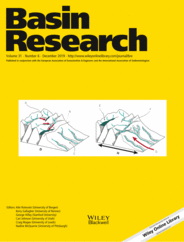
Full text loading...
Lower Cambrian quartz arenitic deposits have a worldwide occurrence. In this study, petrographic and mineralogical analyses were carried out on samples from the quartz‐rich Ringsaker Member of the Vangsås Formation from southern Norway and the corresponding Hardeberga Formation from southern Sweden and on the Danish island of Bornholm. The quartz arenite is almost completely quartz cemented and has an average intergranular volume of 30%. The quartz cement is the dominating cause for porosity loss. Dissolution along stylolites and microstylolites is suggested to be the primary and secondary source for the quartz cement respectively. The quartzose sandstone from southern Norway was severely cemented prior to the Caledonian Orogeny, thus limiting the tectonic influence on diagenesis during thrusting. For most samples, authigenic clay minerals and detrital phyllosilicates represent ca. 5% of the present‐day composition. This, together with a low feldspar content, of on average 4%, indicates that the sediment was extremely quartz‐rich already during deposition. The low amount of feldspar prior to burial and the formation of early diagenetic kaolinite point to weathering, sediment reworking and early diagenesis act as important controls on sediment maturity. The large variation in clay‐mineral and feldspar content between the localities, as well as within the sandstone successions, can be explained by different palaeogeography on the shelf during deposition and subsequently dissimilar subjection to reworking and early diagenetic processes. Weathering in the provenance area, reworking in the depositional shallow‐marine environment and meteoric flushing during the burial stage are suggested to explain the high mineralogical maturity of the lower Cambrian sandstone from southwestern Baltica. These processes may generally account for similar quartz‐rich shallow‐marine sandstone units, deposited as a result of intensive continental denudation and during temperate to subtropical and moderately humid conditions.

Article metrics loading...

Full text loading...
References


Data & Media loading...

